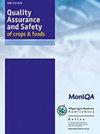Kirenol通过调节NF-κB通路抑制TNF-α-诱导的HaCaT细胞的增殖和迁移
IF 5.3
3区 农林科学
Q1 FOOD SCIENCE & TECHNOLOGY
引用次数: 0
摘要
银屑病是一种常见的慢性炎症性皮肤病,具有炎症细胞浸润和角质形成细胞过度增殖的特性,其发生和发展尚不清楚。因此,本研究旨在确定kirenol(50、100和200μg/mL)对体外培养的人角质形成细胞(HaCaT)的影响,并揭示其分子机制。利用肿瘤坏死因子-α(TNF-α)刺激的HaCaT细胞建立体外银屑病模型。Kirenol是一种二萜化合物,以不同浓度(50、100和200μg/mL)应用于HaCaT细胞24小时。使用细胞计数试剂盒-8(CCK-8)和胸苷一溴脱氧尿苷(BrdU)测定来评估细胞活力和增殖,然后通过Transwell测定评估细胞迁移。随后,通过酶联免疫吸附法(ELISA)测量炎性细胞因子,并使用蛋白质印迹法评估p65、p-p65、IκBα和p-IκB a的表达。分光光度法测定超氧化物歧化酶(SOD)、过氧化氢酶(CAT)、谷胱甘肽(GSH)和丙二醛(MDA)含量。结果表明,TNF-α可显著提高HaCaT细胞的细胞活力和炎性细胞因子,包括白细胞介素-6、IL-8、IL-22和IL-1β的表达,而kirenol可剂量依赖性地抑制其表达。类似地,TNF-α诱导的细胞迁移也被kirenol处理所抑制。此外,TNF-α刺激诱导p65和IκBα以及p-p65-p65和p-IκB a–IκB的磷酸化水平上调,而kirenol显著抑制细胞核因子κB(NF-κB)信号通路的激活。此外,kirenol显著降低MDA水平,但增加SOD、CAT和GSH水平,且呈剂量依赖性。这些结果表明,kirenol可以通过抑制NF-κB信号通路抑制HaCaT细胞的增殖、迁移、炎症因子的表达和氧化应激。本文章由计算机程序翻译,如有差异,请以英文原文为准。
Kirenol inhibits TNF-α-induced proliferation and migration of HaCaT cells by regulating NF-κB pathway
Psoriasis is a common chronic, inflammatory skin disease possessing properties of inflammatory cell infiltration and excessive proliferation of keratinocytes, the occurrence and development of which remain fully elucidated. Therefore, the study was designed to determine the effects of kirenol (50, 100 and 200 μg/mL) on Cultured Human Keratinocytes (cells) (HaCaT) in vitro and reveal its molecular mechanism. The in vitro psoriasis model was established utilizing tumor necrosis factor-α (TNF-α)-stimulated HaCaT cells. Kirenol, a diterpenoid compound, was applied at different concentrations (50, 100 and 200 μg/mL) to HaCaT cells for 24 h. The Cell Counting Kit-8 (CCK-8) and thymidine monobromodeoxyuridine (BrdU) assays were used to assess cell viability and proliferation, followed by assessment of cell migration by Transwell assay. Subsequently, inflammatory cytokines were measured by enzyme-linked immunosorbent assay (ELISA), and Western blot assay was used to evaluate expres-sions of p65, p-p65, IκBα and p-IκBα. Activities of superoxide dismutase (SOD), catalase (CAT), glutathione (GSH) and malondialdehyde (MDA) contents were measured spectrophotometrically. The results demonstrated that TNF-α induced a significant increase in cell viability and inflammatory cytokines, including expressions of Interleukin (IL)-6, IL-8, IL-22 and IL-1β in HaCaT cells, which was dose-dependently inhibited by kirenol. Similarly, TNF-α-induced cell migration was also suppressed by kirenol treatment. Furthermore, TNF-α stimuli induced the upregulation of phosphorylation levels of p65 and IκBα as well as p-p65–p65 and p-IκBα–IκBα ratios, whereas kirenol significantly suppressed the activation of cellular nuclear factor-kappa B (NF-κB) signaling pathway. In addition, kirenol significantly decreased the level of MDA but increased the levels of SOD, CAT and GSH in a dose-dependent manner. These results proposed that kirenol could inhibit the proliferation, migration, expression of inflammatory factors, and oxidative stress in HaCaT cells via suppressing NF-κB signaling pathway.
求助全文
通过发布文献求助,成功后即可免费获取论文全文。
去求助
来源期刊

Quality Assurance and Safety of Crops & Foods
FOOD SCIENCE & TECHNOLOGY-
CiteScore
4.60
自引率
7.50%
发文量
61
审稿时长
1 months
期刊介绍:
''Quality Assurance and Safety of Crops & Foods'' is an international peer-reviewed journal publishing research and review papers associated with the quality and safety of food and food sources including cereals, grains, oilseeds, fruits, root crops and animal sources. It targets both primary materials and their conversion to human foods. There is a strong focus on the development and application of new analytical tools and their potential for quality assessment, assurance, control and safety. The scope includes issues of risk assessment, traceability, authenticity, food security and socio-economic impacts. Manuscripts presenting novel data and information that are likely to significantly contribute to scientific knowledge in areas of food quality and safety will be considered.
''Quality Assurance and Safety of Crops & Foods'' provides a forum for all those working in the specialist field of food quality and safety to report on the progress and outcomes of their research.
 求助内容:
求助内容: 应助结果提醒方式:
应助结果提醒方式:


